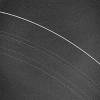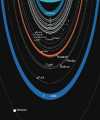This is a false-color view of the rings of Uranus. It was made by combining images taken by Voyager 2 in 1986, from a distance of 4.17 million kilometers (2.59 million miles). The bottom of the image is closest to Uranus and shows the following rings: 6, 5, 4, Alpha, Beta, Eta, Gamma, Delta, and Epsilon. These were the only nine rings known at the time. Later in 1986, Voyager 2 found another two rings, and three more were found by the Hubble Space Telescope in 2003-2005.
Solar System -
Uranus
That Uranus had a ring system was discovered only in 1977. To date (2010), astronomers have discovered a total of 13 rings, with radii ranging from 24,000 miles to about 61,000 miles compared to Uranus' own radius of <16,000 miles. The ring system, while less impressive than Saturn's, is more complex than those of Jupiter or Neptune. While mainly comprising particles, there is some dust in some of the rings. Here is a detailed analysis of Uranus' rings. The rings are a relatively recent phenomenon, having been created about 600 million years ago, probably from collisions between small moons. They are unlikely to last for long. At times, like in 2007 and 2008, the rings are seen from Earth edge-on, virtually disappearing, while at other times, they are seen face on.
In sequence, going outwards from Uranus, the rings are called: Zeta (1986U2R), 6, 5, 4, Alpha, Beta, Eta, Gamma, Delta, Lambda, Epsilon, Nu and Mu. The thirteen rings are classified into three groups.; two dusty rings, nine narrow main rings and two outer rings. The ten inner rings are incredibly thin; only about 100 meters (328 feet) thick, and all but the innermost and outer three are less than 12 km (7½ miles) wide. Some addlitional information about Uranus' Rings is available on the NASA website.
In sequence, going outwards from Uranus, the rings are called: Zeta (1986U2R), 6, 5, 4, Alpha, Beta, Eta, Gamma, Delta, Lambda, Epsilon, Nu and Mu. The thirteen rings are classified into three groups.; two dusty rings, nine narrow main rings and two outer rings. The ten inner rings are incredibly thin; only about 100 meters (328 feet) thick, and all but the innermost and outer three are less than 12 km (7½ miles) wide. Some addlitional information about Uranus' Rings is available on the NASA website.
This is a schematic (to-scale) of the ring and moon system of Uranus
Uranus' Rings
In this photograph, you can see all nine of the narrow main rings that were known when this image was taken in January 1986. The color image below shows the same nine rings. Credit: NASA/JPL
Credit: NASA/JPL




